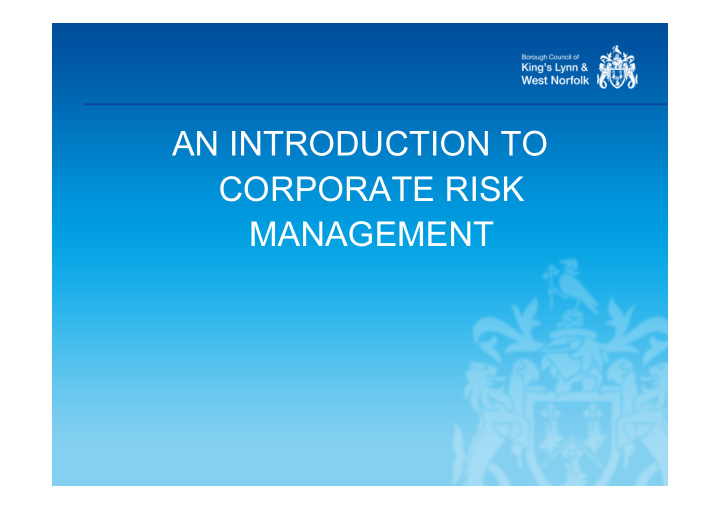



AN INTRODUCTION TO CORPORATE RISK MANAGEMENT
AIMS OF THIS EVENING • Explain some key concepts in risk management • Introduce the Risk Management Policy and Strategy • Provide an overview of the Corporate Risk Management procedures.
WHY DO WE NEED RISK MANAGEMENT? • By recognising and acknowledging risk we can be better prepared to deal with it. • Effective risk management helps the Council to achieve its corporate objectives. • Enable focussing of resources towards the greatest risks • Support accountability
KEY CONCEPTS • Risk – the possibility of an event occurring that will have an impact on the achievement of the objectives. Risk is measured in terms of impact and likelihood • Risk Management – the process by which risks are identified, evaluated and controlled. • Risk appetite – the level of risk that the organisation is willing to accept .
KEY CONCEPTS • Impact - If the event happens, what effect will it have? • Likelihood – how likely is the event to happen? • “Generic” and “Specific” risks • Beware of confusing “risks” and “issues”
RISK MANAGEMENT POLICY & STRATEGY
• Risk Management Policy and Strategy updated February 2016 (Previously combined in one document) • New Policy states the Council’s commitment to managing risk in a positive manner - specifies the aims and objectives • New Strategy sets out how the Policy will be achieved risk evaluation factors and roles and responsibilities.
ROLES AND RESPONSIBILITIES MEMBERS • All Members have a duty to consider risk • Audit and Risk Committee receive monitoring reports twice a year • Reports to Cabinet include a risk assessment
ROLES AND RESPONSIBILITIES MANAGEMENT TEAM • All staff have a duty to consider risk • Overall responsibility for ensuring that the Council manages risk effectively • Chief Executive is the nominated person • Receive half yearly updates on the Risk Register
ROLES AND RESPONSIBILITIES SERVICE MANAGERS • Raise awareness within their own service area • Identify and monitor risk in operational areas
ROLES AND RESPONSIBILITIES INTERNAL AUDIT • Management of the Risk Register • Internal Audit plans and review work considers significant and material risks that have been identified
ROLES AND RESPONSIBILITIES AUDIT and RISK COMMITTEE • Receive Risk Management reports half yearly (Also available on In-Site) • Challenge completeness of coverage and reasonableness of assessment
RISK MANAGEMENT PROCESS
REVIEW PROCESS • Half yearly meetings with Executive Directors • To review and update existing risks and consider any new risks to add • Update Risk Register • Significant new matters can be dealt with on an ad-hoc basis
LIKELIHOOD Likelihood is identified and scored using the definitions contained in the Strategy. • 1 – Rare • 2 – Unlikely • 3 – Possible • 4 – Likely • 5 – Almost Certain
IMPACT Impact is identified and scored using the definitions contained in the Strategy. • 1 – Insignificant • 2 – Minor • 3 – Moderate • 4 – Loss of service for 2 – 7 days (Major) • 5 – Loss of service for more than 7 days (Extreme)
RISK CATEGORY • Risk score is calculated by multiplying the scores for Likelihood and Impact • Score then defines the Risk Category • Determines how the risk will be managed
RISK CATEGORY Risk How the Risk should be managed Category Very High Immediate action required. Senior Management must be involved. (15-25) High Senior Management attention needed and management responsibility specified. (10-12) Medium Manage by specific monitoring or response procedures. (5-9) Low Manage by routine procedures. Unlikely to need specific application of resources. (1-4)
RISK MATRIX 5 (5) (Green) (10) (15) (20) (Red) (25) (Red) (Orange) (Red) Almost certain 4 (4) (8) (Green) (12) (16)(Red) (20) (Red) (Orange) Likely 3 (3) (6) (Green) (9) (12) (15) (Red) (Green) (Orange) Possible 2 (2) (4) (6) (8) (10) (Green) (Green) (Orange) Unlikely 1 (1) (2) (3) (4) (5) (Green) Rare 1 2 3 4 5 Insignificant Minor Moderate Major Extreme
REPORT FORMAT • To concentrate effort on the areas of main concern: • ‘Very High’ risks reported in detail. • ‘High’ risks are only listed for information • Summary of changes since the last report • Complete report available on In-Site
REPORT FORMAT
Any questions?
Recommend
More recommend